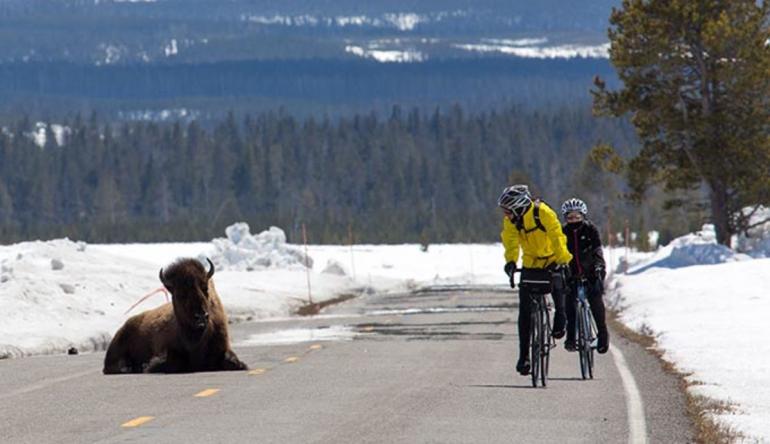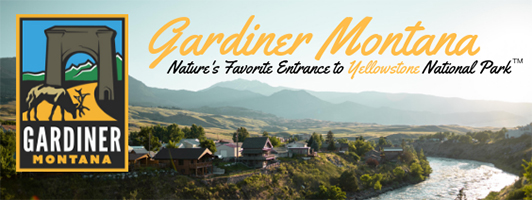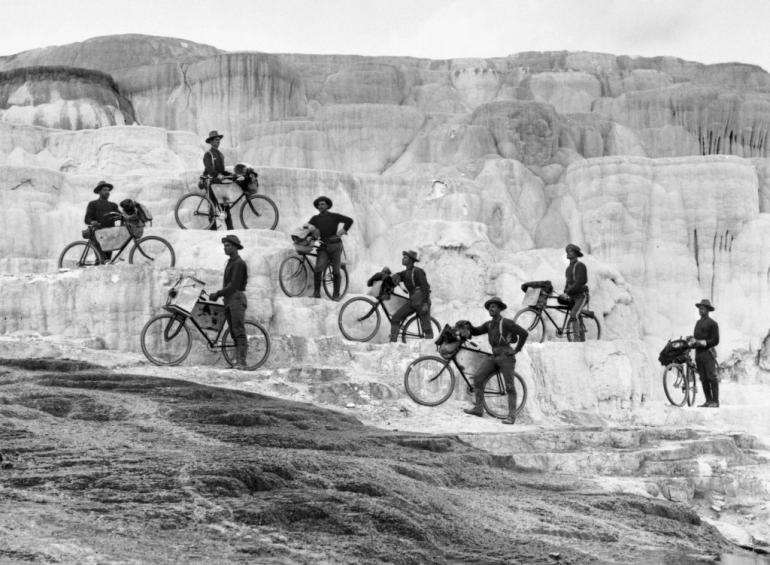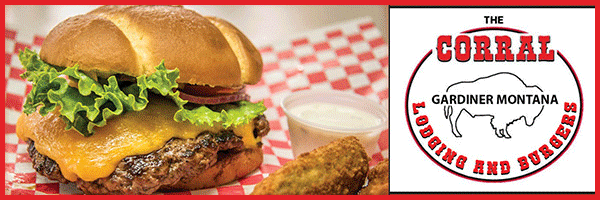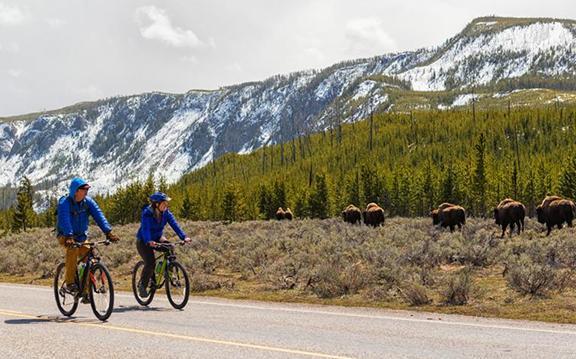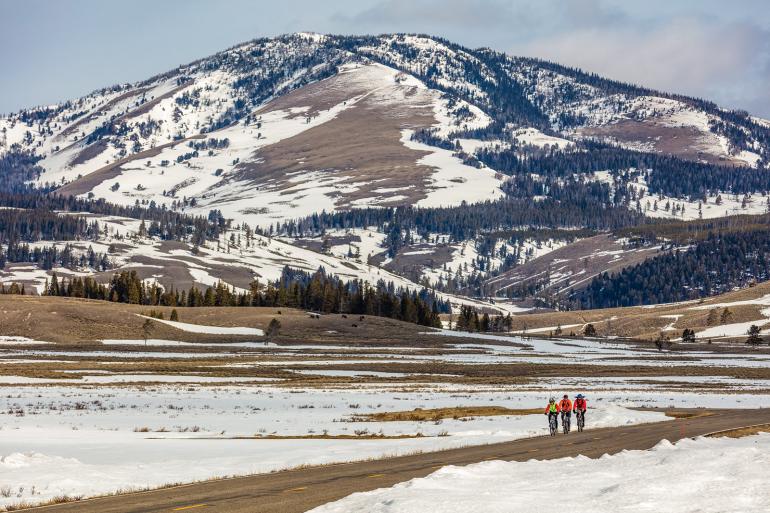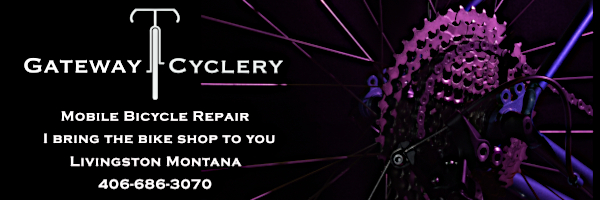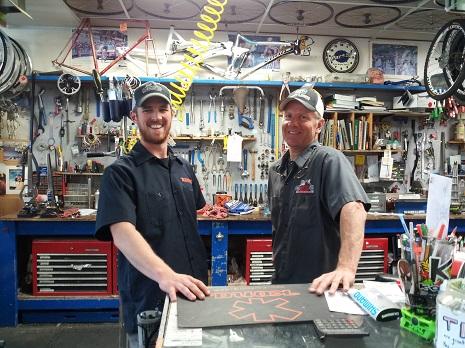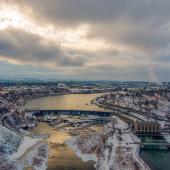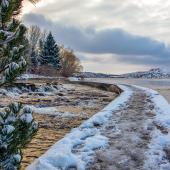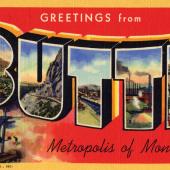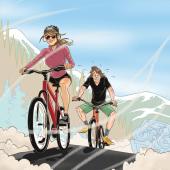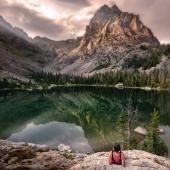Far from the Maddening Crowds
Spring biking in Yellowstone.
In the height of summer, cycling on any of Yellowstone National Park’s main roads seems to be one of those chance adventures where the rider's survival is arguably a matter of luck. Keeping right, wearing safety equipment, and adhering to the rules of the road are barely adequate risk-management strategies in the face of huge RVs, narrow roads, high volumes of traffic, a multitude of driver distractions, and of course the fact that everyone is on vacation. The people who do it impress me with their daring, but it is not an activity I am brave enough to emulate. Lucky for me, I know another option.
During my first visit to Yellowstone, I stumbled onto a local secret. Sometime in April, when the roads have been cleared of snow but not yet opened to traffic, the Park's practically deserted highways and byways are a cyclist’s dream. After an impromptu planning session over an elk burger at The Corral, I was on my way. Although I hadn’t yet experienced the crowds, traffic jams, and slightly hysterical feeling that is summer on a Yellowstone road, I knew we were doing something special as we rode past the traffic barrier above Mammoth Hot Springs into an almost peopleless Park.
What I didn’t know as I ground my way up the three-mile hill to Swan Lake Flat, was that by traveling on a bicycle I was following a time-honored Park tradition. The first cyclists visited Yellowstone in the 1880s, and in the following decade, when technical developments made the bike easier to use and a viable alternative to the horse, cycling in the Park became popular.
Many of the early riders took the same route as my first biking foray: Mammoth to Norris Geyser Basin, albeit with slightly different road conditions. The mixture of obsidian sand, powdered geyserite, and clay found on some stretches of road, in combination with steep grades and wagon-wheel ruts, often made the rides treacherous and difficult. A successful circumnavigation of Yellowstone required a combination of pushing, walking, and riding skills, plus some decent commitment from its pedaling pioneers. However, even with modern bicycles and paved roads, mishaps can still happen. Be sure to get that rusty, neglected chain taken care of before you go with a roadside tune-up from Gateway Cyclery.
But pedal they did. In the 1890s there are accounts of single women and round-the-world cyclists, wheelman clubs, and even a visit by the 25th Battalion Bicycle Corps. The all-black “Buffalo Soldiers,” the first and only bicycle corps, rode from their base in Missoula to Yellowstone and back in the summer of 1896. In the Park, for a little over a week, they attracted intense interest, and their photo on Minerva Terrace is still an iconic cultural image.
25th Infantry Bicycle Corps
Emerging through the Golden Gate, sweaty and out of breath, I was oblivious to the hallowed bike tracks we were following. Our escort for the last part of the climb, sassy ravens whose constant swooping and cawing I took as encouragement, disappeared, and we were left in silence to survey the sweep of Swan Lake Flats. The sprawling meadow, a mishmash of patchy snow, sagebrush, and new grass, was dotted with grazing elk and a scattering of bison. Heads down, they seemed unaware of anything else in their urgency to gain back the energy and weight lost over winter. In the distance, the Gallatin Range, under a layer of snow and dominated by the bulk of Electric Peak, funneled a cold wind across the flats, and in moments we went from being overdressed to underdressed.
It is the time of year when Yellowstone is in transition, winter still firmly established in some places, while in others spring is breathing warmth and color into the landscape. The animals and plants of the Park are emerging with a yawn and a stretch to bask in the milder temperatures, and spring migration is underway. Scores of birds are returning home to the Park from southern climes or using it as a pit stop as they pass over on their way north.
For the bird and animal watcher, anything is possible. There may be grizzly and black bears with newly born cubs, calving bison, herds of elk, and of course there is always the chance of a wolf sighting. The Park’s many species of birds come back for the summer to raise a family. Raptors, sandhill cranes, a multitude of passerines, and others are spring cleaning, performing courtship rituals, and laying eggs. Plant growth may be less obvious than the bustling activity of the animals, but things happen slowly, with wildflowers beginning to bloom and deciduous trees in early bud. Eager to learn about wolf discoveries and grizzlies? Take a bike break and hike around with Adventure Yellowstone Inc.
Encountering a bison herd on the road past Indian Creek, we pulled over and waited, at what we hoped a safe distance, for them to move along. Bison, weighing in between 1,000 and 2,000 pounds, are big and look even bigger from the saddle rather than the safety of a car. Their demeanor seems lethargic, but they are wild animals, moving quick and aggressive when the urge takes them. Our bikes suddenly seemed inadequate, their struts of lightweight metal offering no protection in the face of a bison’s menacing stature. They eventually wandered off, allowing us to continue on our way.
Sometime later a single coyote stood still and silent in a copse of trees by the road, watching us intently as we slowly drew closer. We stopped short of it, and after a long moment the coyote turned, leapt deftly over some brush, and disappeared, leaving us mesmerized, wondering if we had imagined it.
Cycling is an intimate experience, and allows one to see finer detail longer than from the seat of a car. The absence of noise takes this further, allowing one to tap into sounds and, more importantly, silence. Away from the maddening crowds, without having to leave the main road, the cyclist can have a Yellowstone experience that is normally the preserve of backcountry hikers. In the silence it is possible to fully appreciate the native Indian tribes’ perspective on this “land of the burning ground,” as a sacred place with benevolent and helpful spirits, a location worthy of vision questing, prayer making, and the bequeathing of gifts.
It is an opportunity to enjoy a national treasure in a unique way, and without risking a close encounter with an RV. So come April, dust off your bike, pack a good lunch, throw in some warm clothes, and, not forgetting your camera or binoculars, go for a bike ride in Yellowstone National Park.
West-Side Wheelin’
by Carson Sprague
For touring the Park sans tourists, West Yellowstone offers equally excellent two-wheeled access. It’s out and back from the Park entrance, and options vary based on road conditions. Bison are a common sight—often up close and personal—as well as otters, elk, and trumpeter swans. Keep in mind that the weather can be volatile; a rain shell and insulating layer are a good idea, regardless of how sunny it might be when you set out.
Park at the Chamber of Commerce and pop into Freeheel & Wheel for a coffee, spare tube, and advice on what to expect. Then the fun begins—or discomfort, depending on how much you overestimate your early-season fitness. Here are three common turnaround points.
Madison Campground—14 Miles
This is a leisurely ride along the Madison River that’s sure to be a good time. Over the entire 28-mile ride, there isn’t much elevation gain (634 feet) so you’re likely to run into a handful of locals—often with cruiser bikes and blue jeans—enjoying the empty roads during shoulder season.
Norris Geyser Basin—28 Miles
This 56-mile ride is for folks with a bit more time to spare, and who want to get their hearts pumping with over 2,000 feet of vertical. At the end of West Entrance road, hang a left and just keep pedaling up the hill. Enjoy the breathtaking views of Yellowstone in springtime and be sure to stick around a while to watch the geysers go off.
Mammoth—48 Miles
The Big Kahuna. This ride separates the beasts from the babes. If you see it all the way through with an out-and-back, you’ll have conquered a total of 4,248 feet of vert and over 96 miles on two wheels. Continue past Norris and ride among scattered geysers and wildlife galore. Needless to say, this one’s not for the faint of heart—your quads will scream, your throat will hurt, but you’ll have truly earned your après-cycle libations. For a fun—and less taxing—alternative, swap car keys with another group setting out from Gardiner.
Road status
- Road clearing normally starts in early March
- Park gates begin to open for motorized traffic around late April.
- All snowplowing and road opening dates are subject to weather.
- Stick to the pavement, as gravel roads are usually snow-covered.
- There is no spring biking between Madison and Old Faithful due to bear management.
- You can call the Park in late March or early April to check the status of the roads.
Things to Keep in Mind
- Park maintenance staff use the roads, so cycle single file where possible or sensible.
- Wildlife encounters need to be treated with the same respect as in a vehicle.
- Park facilities are not open, so be self-sufficient and prepared for all conditions.
- Stick to the rules of the Park, which includes no biking on trails.
- The only camping options are backcountry sites. They are hike-in only, so plan to stash your bike.
Outfitting Your Mountain Bike for Road Riding
Mountain biking is a dynamic sport; typically you’re on and off your seat a lot as you cover uneven ground. Conversely, recreational road riding or touring requires a lot of time on your butt, pedaling. Because of this, mountain and road bikes are designed with different geometries.
If you are going to use your mountain bike on a paved road, you may want to consider making some adjustments to maximize efficiency and comfort. Doing nothing is one option but there are some simple things you can do that can make a difference.
Here are some tips from local experts 'round town:
- Put more air in your tires. 45-55 psi is ideal for paved roads.
- Consider slick tires, which reduce resistance and require less energy to ride than knobby MTB tires.
- Consider attaching handlebar ends or extensions, which allow multiple hand positions for increased comfort.
- Full-wrap-around, front and back fenders can go a long way toward keeping a rider warm and dry.

